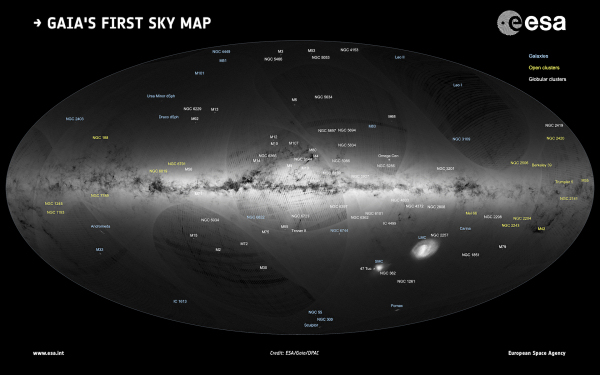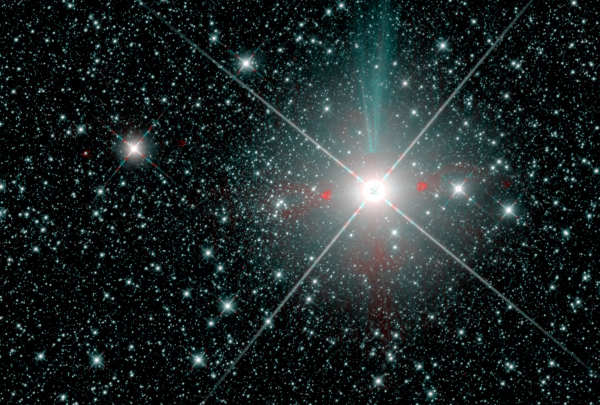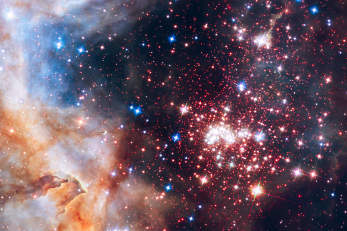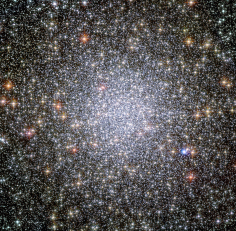How do you find a star cluster? Easy, simply count the stars
15 November 2017
It's the perfect meeting of old and new. Astronomers have combined the latest data from ESA's Gaia mission with a simple analysis technique from the 18th century to discover a massive star cluster that had previously escaped detection. Now, subsequent investigations are helping reveal the star-forming history of our Galaxy, the Milky Way.| Video explainer: How to find a star cluster. (Click here for details and large versions of the video.) Credit: ESA |
In the latter years of the 18th century, astronomers William and Caroline Herschel began to count stars. William called the technique "star gauging" and his aim was to determine the shape of our Galaxy.
Ever since 1609, when Galileo lifted his telescope to the misty patch of light known as the Milky Way and saw that it was composed of myriad faint stars whose light all blurred together, we have known that there are different numbers of stars in different directions throughout space. This means that our local collection of stars, the Galaxy, must have a shape to it. Herschel set out to find out what that shape was.
He used a large telescope, twenty feet (610 cm) in length, mounted between tall wooden frames to sweep out a large circle in the sky that passed through the Milky Way at right angles. He then split this circle into more than 600 regions and counted or estimated the number of stars in each.
With this simple technique the Herschels produced the first shape estimate for the Galaxy. Fast-forward to the 21st century and now researchers use star counts to search for hidden star clusters and satellite galaxies. They look for regions where the density of stars rises higher than expected. These patches are called stellar over-densities.
 |
| Gaia's first sky map. Credit: ESA/Gaia/DPAC. Acknowledgement: A. Moitinho & M. Barros (CENTRA – University of Lisbon), on behalf of DPAC. |
Back in 1785, Herschel's circular track passed close to the brightest star in the night sky Sirius. Now, scientists mining the first data released from the ESA spacecraft Gaia have revisited that particular area of the sky and made a remarkable discovery.
They have revealed a large star cluster that could have been discovered more than a century and a half ago had it not been so close to Sirius.
The cluster was spotted by Sergey E. Koposov, then at the University of Cambridge (UK) and now at Carnegie Mellon University Pennsylvania (USA), and his colleagues. They have been looking for star clusters and satellite galaxies in various surveys for the past decade. It was natural for them to do this with the Gaia mission's first data release.
Gaia is the European Space Agency's astrometric mission. Collecting positions, brightnesses and additional information for more than a billion sources of light, its data allows nothing less than the most precise 'star gauging' ever.
| Gaia scanning the sky. Click here for details and large versions of the video. Credit: ESA/Gaia/DPAC. Acknowledgement: B. Holl (University of Geneva, Switzerland), A. Moitinho & M. Barros (CENTRA – University of Lisbon), on behalf of DPAC. |
These days the laborious task of counting the stars is done by computers but the results still have to be scrutinised by humans. Koposov was combing the list of over-densities when he saw the massive cluster. At first it seemed too good to be true.
"I thought it must be an artefact related to Sirius," he says. Bright stars can create false signals, termed artefacts, that astronomers must be careful not to mistake for stars. An early paper from the Gaia team had even discussed artefacts around Sirius using a nearby patch of sky to the one Koposov was looking at.
Although he moved on and found another over-density that looked promising, his mind kept wanting to return to the first one. "I thought, 'That's strange, we shouldn't have that many artefacts from Sirius.' So I went and looked at it again. And I realised that it too was a genuine object," he says.
These two objects were named: Gaia 1 for the object located near Sirius, and Gaia 2, which is close to the plane of our Galaxy, and both were duly published. Gaia 1 in particular contains enough mass to make a few thousand stars like the Sun, is located 15 thousand light years away, and spread across 30 light years. This means it is a massive star cluster.
Collections of stars like Gaia 1 are called open clusters. They are families of stars that all form together and then gradually disperse around the Galaxy. Our own Sun very likely formed in an open cluster. Such assemblies can tell us about the star formation history of our Galaxy. Finding a new one that can be easily studied is already paying dividends.
"The age is of great interest," says Jeffrey Simpson, Australian Astronomical Observatory, who conducted follow-up observations with colleagues using the 4-metre-class Anglo-Australian telescope at Siding Springs Observatory, Australia.
Identifying 41 members of the cluster, Simpson and colleagues found that Gaia 1 is unusual in at least two ways. Firstly, it is about 3 billion years old. This is odd because there are not many clusters with this age in the Milky Way.
Typically clusters are either younger than a few hundred million years – these are the open clusters – or older than 10 billion years – these are a distinct class called globular clusters, which are found beyond the main bulk of stars in our Galaxy. Being of intermediate age, Gaia 1 might represent an important bridge in our understanding between the two populations.
Secondly, its orbit through the galaxy is unusual. Most open clusters lie close to the plane of the Galaxy but Simpson found that Gaia 1 flies high above it before ducking down and passing underneath. "It might go as much as a kiloparsec (more than 3000 light years) above and below the plane," he says. About 90% of clusters never go more than a third of this distance.
Simulations of clusters with orbits like Gaia 1 find that they are stripped of stars and dispersed by these high velocity 'plane passages'. That puts it at odds with the age estimate.
"Our finding that Gaia 1 is three billion years old is curious as the models would have it not surviving anywhere near as long. More research is required to try and reconcile this," says Simpson.
To test a possible explanation, Alessio Mucciarelli, Universita' degli Studi di Bologna, Italy and colleagues investigated the chemical composition of Gaia 1. Such a study has the ability to see if the cluster formed outside of the Galaxy and has been caught in the act of falling in.
"The chemical composition of the stars can be considered a 'genetic' signature of their origin. If a stellar cluster formed in another galaxy, its chemical composition will be different with respect to that of our Galaxy," says Mucciarelli.
They found that the compositions were practically identical to those expected if Gaia 1 formed in the Milky Way – so the puzzle remains.
Now Mucciarelli hopes that the discrepancy might go away when Gaia releases more data. "Even if the orbital parameters seem to suggest a peculiar orbit, their uncertainties are large enough to prevent any firm conclusion. More accurate orbital parameters will be obtained with the second Gaia data release and we will better understand whether the orbit of Gaia 1 is peculiar or not," he says.
As well as finding new clusters, the Gaia data are proving useful for checking out the reality of previously reported associations of stars. "Using Gaia data I can see stars that share the same motion. So I can confirm which ones form real open clusters," says Andrés E. Piatti, Consejo Nacional de Investigaciones Científicas y Técnicas, Argentina.
He recently published a study that showed ten out of fifteen previously published open clusters were not really star clusters at all, they were just statistical flukes where a lot of unrelated stars happened to be passing in different directions through the same region of space.
It is laborious but vital work. "No one wants to spend their life doing this," says Piatti, "but it is necessary. If we can determine the real size of the cluster population we can learn a lot about the processes that the Galaxy has suffered during its lifetime."
In astronomy, the most famous list of star clusters, nebulae and galaxies was compiled by astronomer and comet hunter, Charles Messier, in the 18th century. Unaware of the importance of these objects, he designed his catalogue to stop the frustration felt by him and other astronomers in mistaking one of these 'deep-sky objects' for a nearby comet.
That original catalogue ran to 110 objects. If it hadn't been for the glare from Sirius obscuring the view, Gaia 1 would have been bright and obvious enough to have made it onto that list too. And there is every reason to think that there are more to come, thanks to Gaia.
The next data release will give accurate proper motions and distances to an unprecedented number of stars, which can be used to more efficiently find star clusters that were buried too deep in the stellar field or were too diffuse or too distant to be seen before.
There is always the possibility to find something totally new too. "I hope with the next data release we can find some new classes of objects too," says Simpson.
For the astronomers ready to explore the Gaia data, the adventure has only just begun. Gaia's second data release is scheduled for April 2018. Subsequent data releases are scheduled for 2020 and 2022.
Background information
A large pan-European team of expert scientists and software developers known as DPAC (Data Processing and Analysis Consortium), located in and funded by many ESA member states, is responsible for the processing and validation of Gaia's data with the final objective of producing the Gaia Catalogue.
Related publications
"Gaia 1 and 2. A pair of new Galactic star clusters," by S. E. Koposov, V. Belokurov and G. Torrealba, is published in Monthly Notices of the Royal Astronomical Society, Volume 470, Issue 3, 21 September 2017, Pages 2702–2709, https://doi.org/10.1093/mnras/stx1182
"Siriusly, a newly identified intermediate-age Milky Way stellar cluster: A spectroscopic study of Gaia 1," by J. D. Simpson, G. M. De Silva, S. L. Martell, D. B. Zucker, A. M. N. Ferguson, E. J. Bernard, M. Irwin, J. Penarrubia and E. Tolstoy is accepted for publication in Monthly Notices of the Royal Astronomical Society, stx1892, https://doi.org/10.1093/mnras/stx1892
"Chemical composition of the stellar cluster Gaia1: no surprise behind Sirius," by A. Mucciarelli, L. Monaco, P. Bonifacio and I. Saviane, is published in Astronomy & Astrophysics, 603 (2017) L7, https://doi.org/10.1051/0004-6361/201731009
"On the physical reality of overlooked open clusters," by A. E. Piatti is published in Monthly Notices of the Royal Astronomical Society, Volume 466, Issue 4, 1 May 2017, Pages 4960–4973, https://doi.org/10.1093/mnras/stx081









